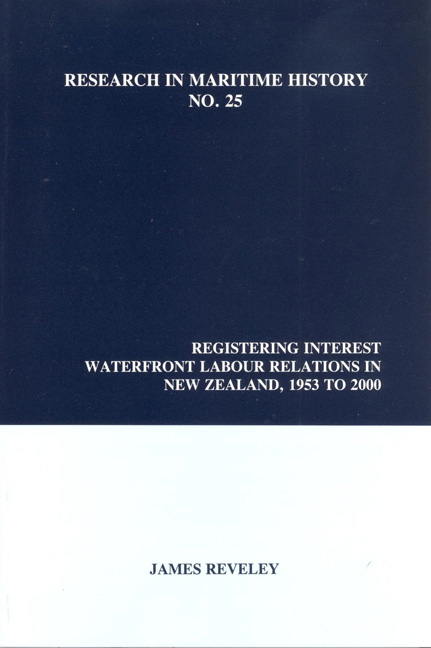Book contents
- Frontmatter
- Contents
- About the Author
- List of Figures
- List of Tables
- Acknowledgments
- Introduction
- Chapter 1 Unions and the Bureau System
- Chapter 2 The Waterfront Employers: Companies and Coordination Mechanisms
- Chapter 3 Labour Relations in the Conventional Cargo Era
- Chapter 4 Negotiating Technological Change
- Chapter 5 Labour Relations after Containerisation
- Chapter 6 Waterfront Labour Reform
- Conclusion
Chapter 5 - Labour Relations after Containerisation
- Frontmatter
- Contents
- About the Author
- List of Figures
- List of Tables
- Acknowledgments
- Introduction
- Chapter 1 Unions and the Bureau System
- Chapter 2 The Waterfront Employers: Companies and Coordination Mechanisms
- Chapter 3 Labour Relations in the Conventional Cargo Era
- Chapter 4 Negotiating Technological Change
- Chapter 5 Labour Relations after Containerisation
- Chapter 6 Waterfront Labour Reform
- Conclusion
Summary
The preceding chapter identified a series of union-enforced restrictions that limited the flexibility of employers in dealing with technological change. These outcomes were consolidated by the unions’ organisational cohesiveness and increasing employer disunity from the early 1970s until the mid-1980s. The Waterside Workers Federation (WWF) forestalled the segmentation of its membership by securing the rotation of workers through the container terminals. Instead it was the employers as a group who became fragmented after containerisation. Although the Port Employers Association (PEA) was a centralised association, and the watersiders’ national organisation was only a loosely knit federation, paradoxically the port unions had more success at acting in concert than the employers. This pattern persisted even after the employers reorganised on a more inclusive basis, sparking calls for waterfront reform.
Union Strategies and Tactics
Throughout the 1970s the internal strength of the WWF and its member unions increased steadily. The divisions within the WWF, which had erupted in 1970 when the Auckland and Wellington watersiders’ unions refused to ratify General Principal Order (GPO) 305, had been resolved to the point that they did not reappear in bargaining. The WWF accommodated some of the larger unions - like Auckland - by allowing negotiations over local conditions to precede national talks. Any lingering tension within the WWF was manifested only internally, precluding the transformation of the WWF into a national union. In general, the local autonomy of the individual port unions did not sap the WWF's external strength, which led Federation officials to continue to oppose compulsory arbitration until it was abolished in 1984, opting instead for strike action.
Although the ports industry had its own specialised legal framework for labour relations, bargaining was nonetheless influenced by the centralised wagesetting arrangements of the arbitration system generally. The breakdown of this system was brought to a head when the 1968 nil General Wage Order issued by the Arbitration Court undermined its role in setting wages. Upward wage drift that resulted from regional- and enterprise-level bargaining led the government in 1971 to introduce wage controls that continued to operate until 1977.
Information
- Type
- Chapter
- Information
- Registering InterestWaterfront Labour Relations In New Zealand, 1953 To 2000, pp. 113 - 138Publisher: Liverpool University PressPrint publication year: 2003
